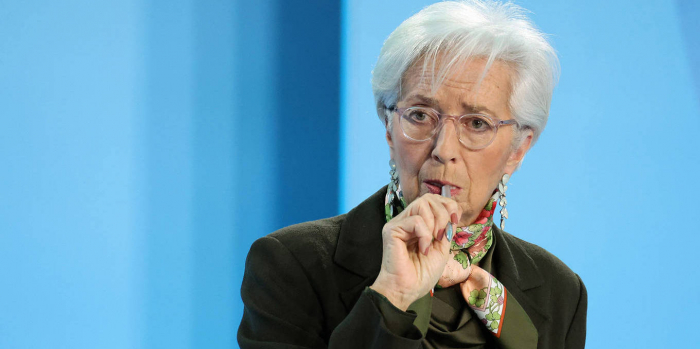While the European Central Bank has hiked interest rates rapidly to make up ground in its fight against resurgent inflation, it is having a harder time reversing years of massive asset purchases. How can policymakers remove surplus liquidity without creating even bigger problems?
It is now widely acknowledged that most central banks underestimated the threat of inflation when they persisted with extremely low interest rates and massive asset purchases throughout 2021 and into 2022. Fortunately, when they did finally change course, they showed remarkable determination, with the European Central Bank raising interest rates by 375 basis points in less than a year (and the US Federal Reserve raising its policy rate by 500 basis points).
But reversing the policy of massive bond purchases is proving more difficult. A decade of quantitative easing (QE) has significantly expanded the ECB’s balance sheet and created a liquidity glut, leaving policymakers in a trap from which they are struggling to escape.
The size of the ECB’s balance sheet peaked at nearly €9 trillion ($9.6 trillion) in 2022, when the volume of its bond purchases amounted to around 56% of eurozone GDP. Though it ended its net purchases of securities in July 2022, and though cuts to the subsidy that banks could earn on targeted longer-term refinancing operations (TLTROs) led them to repay large sums, the excess liquidity in the banking system still amounts to around €4 billion.
True, in March, the ECB started decreasing what it was reinvesting from maturing securities by €15 billion per month. Following the governing council’s May 4 meeting, the ECB expects to reduce its balance sheet by €25 billion per month from July 2023 onward.
Given the scale of the ECB’s bond holdings, however, its approach to quantitative tightening (QT) seems downright homeopathic. At the current rate, bringing the asset-purchase program to zero will take roughly 15 years (and this does not even account for the fact that the ECB continues to reinvest all maturing assets purchased under the Pandemic Emergency Purchase Program).
These issues raise a fundamental question about the relationship between the ECB’s interest-rate policy and its securities transactions. When it comes to cutting interest rates to stimulate aggregate demand, the zero-bound acts as a lower limit.
If interest rates fall into negative territory, it becomes economically attractive to withdraw bank deposits and exchange them for cash. By contrast, there is no limit to how much interest rates can be hiked, and, as the past year of monetary policymaking has shown, the policy rate has become central banks’ primary instrument again.
But what role do bond purchases and sales play in this new context? While additional net purchases of securities would be counterproductive in the fight against inflation, net sales of securities would reduce commercial banks’ surplus liquidity. The same goes for scaling back special measures such as the TLTROs. The associated increase in a bank’s cost of refinancing will boost the anti-inflationary effect of the interest-rate hike.
Owing to the direct effect of QT on bank liquidity, the timing and extent of the ECB’s efforts to unwind its balance sheet must account for financial-market conditions. There is a certain asymmetry between QE and QT, in that banks may have become accustomed to a high liquidity position after an extended period of selling large volumes of securities to the central bank. Moreover, when considering how much to reduce excess liquidity, the ECB will have to account for any changes in the regulatory environment.
But such considerations are not an argument against swiftly reducing net security holdings when QT is being deployed from a starting point of extremely high surplus liquidity, because one must account for fiscal policies as well.
The massive fiscal stimulus that was deployed to stabilize the eurozone economy during the pandemic, and then during the past year’s energy crisis, has relied heavily on central-bank bond purchases. QE largely eliminated the risk that the financing of high public deficits would lead to a significant rise in interest rates.
The ECB’s hesitation to pursue a forceful QT policy thus fosters expectations that fiscal policies will continue to be expansionary, which will ultimately extend the period of too-high inflation. We are witnessing a case of fiscal dominance.
But if the ECB keeps its massive bond holdings in its portfolio, there will be less monetary-policy space in the next crisis. What effect would another huge wave of bond purchases have if the central bank is starting from its current bloated position? It is safe to say that the picture would not be pretty.
Central banks need to extricate themselves from this situation for the sake of their own independence and credibility. In the ECB’s case, the problem is exacerbated by the fact that its massive bond purchases have held down interest rates for bonds issued by highly indebtedmember states, thus reducing pressure on those governments to consolidate their public budgets.
Striking the right balance between interest-rate policies and QT will not be easy. But as a guide for their decision-making, central banks should stay focused on their primary mandate of maintaining price stability. That will be the best way to ward off the growing threat to their independence.1Otmar Issing, former chief economist and member of the board of the European Central Bank, is Honorary President of the Center for Financial Studies at Goethe University Frankfurt.
Otmar Issing, former chief economist and member of the board of the European Central Bank, is Honorary President of the Center for Financial Studies at Goethe University Frankfurt.
More about:
















































